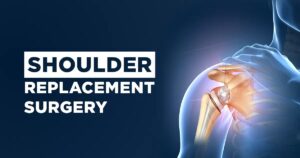
The shoulder is one of the most complex and flexible joints in the human body, allowing us to lift, push, pull, and rotate our arms in countless ways. But when arthritis, injury, or degeneration damages the shoulder joint, pain and stiffness can severely limit everyday activities. Total shoulder replacement– also known as total shoulder arthroplasty — is an advanced surgical option designed to relieve pain, restore mobility, and significantly improve quality of life.
In this article, we’ll explore what total shoulder replacement involves, who might benefit, what to expect from surgery and recovery, and how it can help you regain an active, pain-free lifestyle.
Understanding the Shoulder Joint:
The shoulder is a ball-and-socket joint, where the round head of the upper arm bone (humerus) fits into the shallow socket (glenoid) of the shoulder blade (scapula). It is stabilized and moved by muscles, tendons, and ligaments, notably the rotator cuff.
When healthy, smooth cartilage covers the surfaces of the bones, allowing the joint to glide painlessly. But when this cartilage wears away or is damaged, bone rubs against bone — causing pain, inflammation, and restricted motion.
Causes of Shoulder Joint Damage:
Several Conditions Can Lead to Joint Degeneration That May Require Total Shoulder Replacement:
-
Osteoarthritis (wear-and-tear arthritis)
-
Rheumatoid arthritis (autoimmune inflammatory arthritis)
-
Post-traumatic arthritis (following injury or fracture)
-
Rotator cuff tear arthropathy (arthritis after chronic rotator cuff tears)
-
Avascular necrosis (bone death from disrupted blood supply)
-
Severe fractures of the shoulder joint
What Is Total Shoulder Replacement?
Total shoulder replacement is a surgical procedure where damaged parts of the shoulder joint are removed and replaced with artificial components (prostheses).
These Components Typically Include:
-
A metal ball that replaces the head of the humerus
-
A plastic socket that replaces the glenoid cavity
The goal is to recreate a smooth, pain-free joint surface that restores functional movement.
There Are Two Main Types of Shoulder Replacement:
-
Anatomic Total Shoulder Replacement – replicates the natural anatomy and is used when the rotator cuff is intact.
-
Reverse Total Shoulder Replacement – switches the position of the ball and socket, used when the rotator cuff is severely damaged or torn.
Who Is a Candidate?
You May Be a Good Candidate for Total Shoulder Replacement if You Have:
-
Severe shoulder pain that interferes with daily activities (dressing, grooming, reaching)
-
Limited shoulder motion
-
Failed non-surgical treatments (medications, physical therapy, injections)
-
X-rays or imaging showing advanced joint damage
An orthopedic surgeon will evaluate your condition, overall health, and treatment goals to determine suitability.
The Surgical Procedure:
Before surgery, patients undergo imaging studies, a physical examination, and preoperative medical evaluations.
During surgery (typically lasting 1.5 to 3 hours):
-
The surgeon makes an incision over the shoulder
-
Damaged bone and cartilage are removed
-
Artificial components are implanted and secured
-
The incision is closed, and the shoulder is bandaged
Most surgeries are performed under general anesthesia, often combined with a nerve block for pain relief.
Recovery & Rehabilitation:
Hospital stays typically range from 1 to 3 days, though some patients may go home the same day depending on the case and facility.
Initial Recovery Includes:
-
Wearing a sling to immobilize the shoulder for 2–6 weeks
-
Pain management with medications
-
Gentle range-of-motion exercises under guidance
Rehabilitation Phases:
-
Weeks 0–6: Passive motion exercises; avoid lifting or strenuous use
-
Weeks 6–12: Active motion and gentle strengthening
-
3–6 months: Progressive strengthening and return to functional activities
Most patients regain significant pain relief and improved shoulder motion within 3–6 months, with full recovery often taking up to a year.
Expected Outcomes:
Studies show that over 90% of patients experience substantial pain relief, improved shoulder strength, and increased range of motion after total shoulder replacement.
Many Patients Return to:
-
Recreational sports like swimming, golf, or tennis (non-contact)
-
Everyday activities like grooming, cooking, and driving
Prosthetic components are highly durable, with success rates of 85–90% at 10–15 years post-surgery, depending on activity level and surgical technique.
Risks & Complications:
While generally safe and effective, as with any surgery, total shoulder replacement carries some risks:
-
Infection
-
Blood clots
-
Nerve injury
-
Shoulder stiffness or instability
-
Implant loosening or wear over time
Choosing an experienced orthopedic surgeon and adhering to postoperative rehabilitation minimizes complications.
Conclusion:
Total shoulder replacement is a proven and effective surgical option that can restore mobility, relieve chronic pain, and dramatically improve quality of life for individuals with severe shoulder joint damage. With modern surgical techniques, durable implants, and structured rehabilitation, most patients achieve long-lasting and satisfying outcomes.
If shoulder pain is limiting your life and non-surgical treatments have failed, consult an orthopedic specialist to explore whether shoulder replacement might be the right solution for you.
Total Shoulder Replacement Surgery in Delhi by Dr. Anant Kumar Tiwari. Dr Anant Kumar is an orthopaedic surgeon who performs reverse shoulder surgery and total shoulder replacement surgery in Delhi, India Regain shoulder function and improve your quality of life with our advanced care.